Content for TS 23.558 Word version: 19.2.0
0…
5…
6…
6.2a…
6.2b…
6.3…
6.4…
7…
8…
8.3…
8.3.3…
8.3.3.3…
8.4…
8.4.3…
8.4.4…
8.5…
8.6…
8.6.3…
8.6.4…
8.6.6…
8.7…
8.8…
8.8.2.5…
8.8.2A…
8.8.3…
8.8.4…
8.8.5…
8.9…
8.14…
8.14.3…
8.15…
8.17…
8.17.3…
8.17.4…
8.18…
8.19…
8.20…
9…
A…
A.4…
A.5…
B…
E…
8.3.3 Service provisioning
8.3.3.1 General
8.3.3.2 Procedures
8.3.3.2.1 General
8.3.3.2.2 Request-response model
8.3.3.2.3 Subscribe-notify model
8.3.3.2.3.1 General
8.3.3.2.3.2 Subscribe
8.3.3.2.3.3 Notify
8.3.3.2.3.4 Subscription update
8.3.3.2.3.5 Unsubscribe
...
...
8.3.3 Service provisioning p. 63
8.3.3.1 General p. 63
The following clauses specify procedures, information flows and APIs for service provisioning.
8.3.3.2 Procedures p. 63
8.3.3.2.1 General p. 63
Following procedures are supported for service provisioning:
- Request-response procedure;
-
Subscribe-notify procedures, including:
- Subscription procedure;
- Notification procedure;
- Subscription update procedure; and
- Unsubscribe procedure.
8.3.3.2.2 Request-response model p. 64
Figure 8.3.3.2.2-1 illustrates service provisioning procedure based on request/response model.
Pre-conditions:
- The EEC has been pre-configured or has discovered the address (e.g. URI) of the ECS;
- The EEC has been authorized to communicate with the ECS;
- The UE Identifier is either preconfigured or resulted from a successful authorization; and
- The ECS is configured with ECSP's policy for service provisioning.
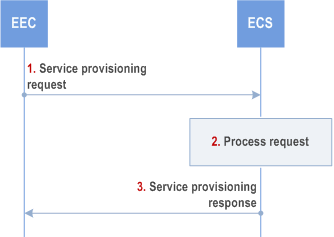
Step 1.
Step 2.
Step 3.
If the service provisioning response contains a list of ECS configuration information, the EEC may initiate service provisioning procedure with one or more ECS(s) provided in the response. If the UE is roaming to a V-PLMN and the ECS configuration information includes V-PLMN ID in the list of Supported PLMN ID(s), the EEC may establish a connection with the V-ECS based on parameters such as UE serving PLMN ID and supported PLMN ID(s) of the V-ECS received in the response message as specified in TS 23.548. The connection with the V-ECS can be a HR-SBO PDU session or an LBO PDU session based on the information received from the ECS.
If the EDN configuration information includes an LADN DNN as an identifier for the EDN, the EEC considers the LADN as the EDN. Therefore, the service area of EDN is the LADN Service Area which can be discovered using the UE Registration Procedure.
The EEC may cache the service provisioning information (e.g. EES endpoint) for subsequent use and avoid the need to repeat step 1. If the Lifetime IE is included in the Service provisioning response, then the EEC may cache and reuse the Service provisioning information only for the duration specified by the Lifetime IE, without the need to repeat step 1.
If the ECS provided information regarding the service continuity support of individual EESs, the EEC may take this information into account when selecting an EES for EEC registration, EAS discovery or T-EAS discovery, respectively.
If for multiple EES(s), the instantiable EAS information IE for an EAS is not available or the instantiable EAS information IE is set to instantiated or instantiable, the EEC can select one or more such EES to perform EAS discovery. For EAS discovery to mitigate the waste of EDN resources EEC considers the instantiable EAS information and the associated instantiation criteria, the EEC selects one EES, if the EAS instantiation status corresponding to the EASID requested by AC/EEC is instantiable but not yet instantiated (i.e. no instantiated EAS).
The EEC sends a service provisioning request to the ECS. The service provisioning request includes the security credentials of the EEC received during EEC authorization procedure and may include the UE identifier such as GPSI, connectivity information, UE location, EEC service continuity support and AC profile(s) information. EEC may provide its desired ECSP identifier(s) in the service provisioning request based on EEC preference.
Step 2.
Upon receiving the request, the ECS performs an authorization check to verify whether the EEC has authorization to perform the operation. The ECS may utilize the capabilities (e.g. UE location) of the 3GPP core network as specified in clause 8.10.2. If the UE serving PLMN identifier is not provided by the EEC in the connectivity information of the service provisioning request, the ECS may invoke the NEF monitoring event API as described in TS 23.502 and TS 23.682 to obtain the UE roaming status and serving PLMN identifier. If the UE is roaming, the ECS may use the serving PLMN identifier to determine the roaming partner ECS (i.e. V-ECS) information to be provided to the EEC in the service provisioning response. If the Prediction expiration time is provided then the ECS may determine whether to identify EES with the instantiable but not instantiated EAS based on the Prediction expiration time and predicted EAS deployment time information obtained from ADAES or from local configured maximum EAS deployment time. If AC profile(s) are provided by the EEC, and the Application group profile is not provided, the ECS identifies the EES(s) based on the provided AC profile(s) and the UE location.
When Application group profile is provided in the request, which applies to the common EAS case:
-
if the ECS-ER is not available, then
- the ECS identifies EES(s) based on the information contained in the request (e.g.AC profile, Application group profile, UE location), specifically, the ECS identify the EES(s) based on the EASID and expected group geographical service area in the application group profile and the EAS ID supported by the EES and EES(s) service area in EES profile(s);
-
if the ECS-ER is available, and:
- EES information is not available corresponding to the Application Group ID, then the ECS identifies EES(s) and stores the identified EES(s)'s information and related Application group ID into the ECS-ER; specifically, the ECS identify the EES(s) based on the EASID and expected group geographical service area in the application group profile and the EAS ID supported by the EES and EES(s) service area in EES profile(s); or
- EES information is available corresponding to the Application Group ID, then the ECS retrieves the EES (s) information corresponding to the Application Group ID from the ECS-ER.
- if available, the ECS identifies the EES(s) based on the UE-specific service information at the ECS and the UE location;
- ECS identifies the EES(s) by applying the ECSP policy (e.g. based only on the UE location);
- If bundle EAS information includes EAS bundle identifier, the ECS identifies all the EES(s) providing the same EAS bundle identifier.
- If bundle EAS information includes a list of EASIDs, the ECS identifies the one or more EES which support all of the EASs within the same EDN based on the EDN information obtained in the EES profile.
Step 3.
If the processing of the request was successful, the ECS responds to the EEC's request with a service provisioning response. If the ECS has identified the relevant EES(s) information, the service provisioning response includes a list of EDN configuration information, e.g. identification of the EDN, EDN service area, and the required information (e.g. URI, IP address) for establishing a connection to the EES.
The ECS may provide associated EES(s) information (one or more EES information) in the service provisioning response along with the bundle EAS information.
If the alternative ECS(s) has been identified in step 2, the ECS sends a successful response including the Redirect information element containing the list of ECS(s) configuration information indicating that alternative ECS(s) is available for service provisioning request. The response may include information such as DNN and S-NSSAI for roaming UEs to establish a PDU session with the ECS as specified in TS 23.548.
If the ECS is not provisioned with any EDN configuration information or is unable to determine either the EES information or the partner ECS information using the inputs in service provisioning request, UE-specific service information at the ECS or the ECSP's policy, the ECS shall reject the service provisioning request and respond with an appropriate failure cause.
8.3.3.2.3 Subscribe-notify model p. 66
8.3.3.2.3.1 General p. 66
Clause 8.3.3.2.3.2 and clause 8.3.3.2.3.3 together illustrate the service provisioning procedure based on Subscribe/ Notify model.
Clause 8.3.3.2.3.4 illustrates the service provisioning update procedure.
Clause 8.3.3.2.3.5 illustrates the service provisioning unsubscribe procedure.
8.3.3.2.3.2 Subscribe p. 67
Figure 8.3.3.2.3.2-1 illustrates the service provisioning subscription procedure between the EEC and the ECS.
Pre-conditions:
- The EEC has been pre-configured or has discovered the address (e.g. URI) of the ECS;
- The EEC has been authorized to communicate with the ECS as specified in clause 8.11;
- The UE Identifier is either preconfigured or resulted from a successful authorization;
- The ECS is configured with ECSP's policy for service provisioning; and
- The EEC has optionally acquired a Notification Target Address to be used in its subscriptions to notifications.
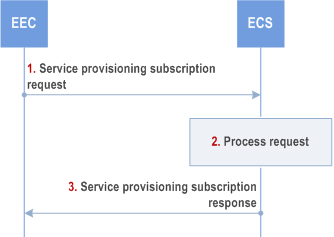
Step 1.
The EEC sends a service provisioning subscription request to the ECS. The service provisioning subscription request includes the security credentials of the EEC received during EEC authorization procedure and Notification Target Address (e.g. URL) and may include the UE identifier such as GPSI, connectivity information, proposed expiration time and AC Profile information. EEC may provide its desired ECSP identifier(s) in the service provisioning request based on EEC preference.
If the application triggering is supported and required by the EEC, the EEC may include the EEC Triggering Request information element instead of the Notification Target Address in the request message.
Step 2.
Upon receiving the request, the ECS performs an authorization check to verify whether the EEC has authorization to perform the operation. If required, the ECS may utilize the capabilities (e.g. UE location or user plane management event notification service if available) of the 3GPP core network as specified in clause 8.10.2. If the request is authorized, the ECS creates and stores the subscription for provisioning.
Step 3.
If the processing of the request was successful, the ECS responds with a service provisioning subscription response, which includes the subscription identifier and may include the expiration time, indicating when the subscription will automatically expire. To maintain the subscription, the EEC shall send a Service provisioning subscription update request prior to the expiration time. If a Service provisioning subscription update request is not received prior to the expiration time, the ECS shall treat the EEC as implicitly unsubscribed.
If the ECS is unable to determine the EES information using the inputs in service provisioning subscription request, UE-specific service information at the ECS or the ECSP policy, the ECS shall reject the service provisioning subscription request and respond with an appropriate failure cause.
8.3.3.2.3.3 Notify p. 68
Figure 8.3.3.2.3.3-1 illustrates the service provisioning notification procedure between the EEC and the ECS.
Pre-conditions:
- The EEC has subscribed with the ECS for the provisioning information as specified in clause 8.3.3.2.3.2.
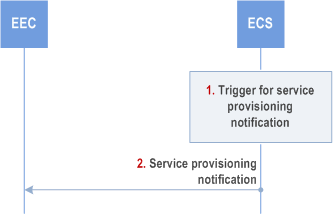
Step 1.
Step 2.
If the service provisioning notification contains a list of ECS configuration information, the EEC may initiate service provisioning procedure with one or more ECS(s) provided in the notification. If the UE is roaming to a V-PLMN and the ECS configuration information includes V-PLMN ID in the list of Supported PLMN ID(s), the EEC establishes a PDU session with the V-PLMN to access the ECS in the visited network as specified in TS 23.548.
If the EDN configuration information in the service provisioning notification includes an LADN DNN as an identifier for the EDN, the EEC considers the LADN as the EDN. Therefore, the service area of EDN is the LADN Service Area, which can be discovered using the UE Registration Procedure.
If the ECS provided information regarding the service continuity support of individual EESs, the EEC may take this information into account when selecting an EES for EEC registration, EAS discovery or T-EAS discovery, respectively.
After the EEC establishes a connection to an EES using information received in step 2, the EES can issue an AF request to influence traffic routing as specified in clause 5.6.7 of TS 23.501 in order to influence the user plane path to this connected EES.
An event occurs at the ECS that satisfies trigger conditions for updating service provisioning of a subscribed EEC. If UE's location information is not available, the ECS may obtain the UE location by utilizing the capabilities of the 3GPP core network as specified in clause 8.10.2. If the UE serving PLMN identifier is not provided by the EEC in the connectivity information of the service provisioning request, the ECS may invoke the NEF monitoring event API as described in TS 29.522 and TS 29.122 to obtain the UE roaming status and serving PLMN identifier. If the UE is roaming, the ECS may use the serving PLMN identifier to determine the partner ECS information to be provided to the EEC in the service provisioning notification. If AC profile(s) were provided by the EEC during subscription creation, the ECS identifies the EES(s) based on the provided AC profile(s) and the UE location. If AC profiles(s) were not provided, then:
- if available, the ECS identifies the EES(s) based on the UE-specific service information at the ECS and the UE location;
- ECS identifies the EES(s) by applying the ECSP policy (e.g. based only on the UE location);
- If bundle EAS information included EAS bundle identifier, the ECS identifies all the EES(s) providing the same EAS bundle identifier.
- If bundle EAS information includes a list of EASIDs, the ECS identifies the one or more EES which support all of the EASs within the same EDN based on the EDN information obtained in the EES profile.
Step 2.
The ECS sends a provisioning notification to the EEC. If the ECS has identified the relevant EES(s) information, the service provisioning notification includes the list of EDN configuration information determined in step 1. If the ECS has determined suitable partner ECS(s), the service provisioning notification includes a list of ECS configuration information and may include information for roaming UEs to establish PDU session with the ECS as specified in TS 23.548. The ECS may provide associated EES(s) information (one or more EES information) in the service provisioning response along with the bundle EAS information.
8.3.3.2.3.4 Subscription update p. 69
Figure 8.3.3.2.3.4-1 illustrates the service provisioning subscription update procedure between the EEC and the ECS.
Pre-conditions:
- The EEC has subscribed with the ECS for the provisioning information as specified in clause 8.3.3.2.3.2.
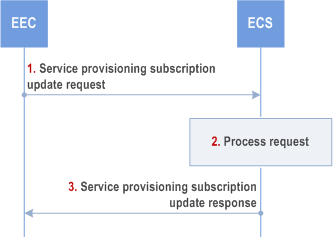
Step 1.
The EEC sends a service provisioning subscription update request to the ECS. The service provisioning subscription update request includes the security credentials of the EEC received during EEC authorization procedure along with the subscription identifier and may include the UE identifier such as GPSI, connectivity information, proposed expiration time for the updated subscription and AC profile(s).
Step 2.
Upon receiving the request, the ECS performs an authorization check to verify whether the EEC has authorization to perform the operation. If required, the ECS may utilize the capabilities (e.g. UE location) of the 3GPP core network as specified in clause 8.10.2. If authorized, the ECS updates the stored subscription for provisioning as requested in step 1.
Step 3.
The ECS responds with a service provisioning subscription update response, which may include the expiration time, indicating when the updated subscription will automatically expire. To maintain the subscription, the EEC shall send a Service provisioning subscription update request prior to the expiration time. If a Service provisioning subscription update request is not received prior to the expiration time, the ECS shall treat the EEC as implicitly unsubscribed.
8.3.3.2.3.5 Unsubscribe p. 70
Figure 8.3.3.2.3.5-1 illustrates the service provisioning unsubscribe procedure between the EEC and the ECS.
Pre-conditions:
- The EEC has subscribed with the ECS for the provisioning information as specified in clause 8.3.3.2.3.2.
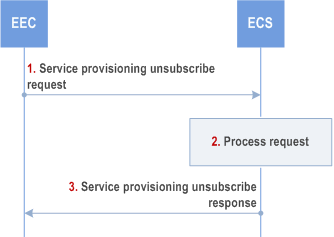
Step 1.
The EEC sends a service provisioning unsubscribe request to the ECS. The service provisioning unsubscribe request includes the security credentials of the EEC received during EEC authorization procedure along with the subscription identifier.
Step 2.
Upon receiving the request, the ECS performs an authorization check to verify whether the EEC has authorization to perform the operation. If authorized, the ECS cancels the subscription for provisioning as requested in step 1.
Step 3.
The ECS responds with a service provisioning unsubscribe response.